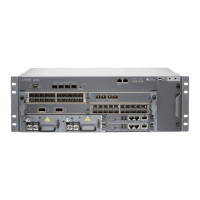Table 19: Management LEDs
DescriptionStateColorLocationName
1000-Mbps link is online.OnGreenLeftLink
100-Mbps link is online.OnYellow
10-Mbps link is online.Off–
The port is receiving data.BlinkingYellowRightActivity
The port is not receiving data.Off–
MX104 Boot Sequence
The MX104 router ships with Junos OS preinstalled and ready to be configured when the
router is powered on. One eight-GB internal NAND Flash memory (da0) acts as the hard
drive. Two USB ports on the front panel accept USB storage devices (usb0 and usb1)
that can also function as alternative boot devices.
When the router boots, it first attempts to start the image on the USB 0 flash memory
device, if present, then attempts to start the image on the USB 1 flash memory device, if
present. If a USB flash memory device is not inserted into either of the two slots on the
Routing Engine, or the attempt otherwise fails, the router next tries the active partition
on the NAND Flash device.
Related
Documentation
Maintaining the MX104 Routing Engines on page 192•
• Replacing an MX104 Routing Engine on page 152
Routing Engine Specifications
Table 20 on page 31 lists the current specifications for Routing Engines supported on
M Series, MX Series, and T Series routers. Table 21 on page 32 lists the specifications for
end-of-life Routing Engines.
NOTE: For a list of the routing engines that are supported on the M Series,
MX Series, T Series, and PTX routers, see “Supported Routing Engines by
Router” on page 33.
NOTE: For information about PTX Series Routing Engine specifications, see
Routing Engines Supported on PTX Series Routers. For information about
Copyright © 2017, Juniper Networks, Inc.30
MX104 3D Universal Edge Router Hardware Guide

